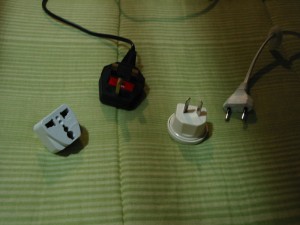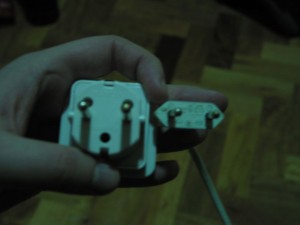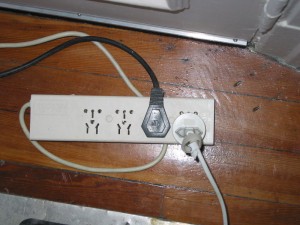A few days ago, I finally picked up some plug converters. They’re actually surprisingly tricky to find. No regular electronics/appliance stores carry them. I’m told that there are occasionally vendors who walk around tourist areas selling adapters, but I haven’t seen these. I found mine at a stand at one of the weekly street fairs. I’ve heard a couple explanations for the difficulty, but I don’t know how accurate they are.
One guy told me that it’s against the law to sell adapters because they want to force people to buy Argentinian electrical products, rather than bringing in foreign ones. It’s true that high-end electronics are generally cheaper in North America than here, and I’ve talked to Argentinians who make a point of buying digital cameras and computers on their visits to the States. Still, I really doubt there are enough of these people to warrant a law banning the sale of power converters. Plus, wouldn’t those people just buy adapters abroad too?
Another explanation was similar, but with the justification that because Argentina is in the process of changing from an European Type C plug standard, to an Australian/Chinese Type I plug (oh, but they wire them the opposite way!), and they don’t want you using converters to cling to the old standard. Why Argentina feels the need to change their national plug standard, I’m not sure. Today, it’s common to see both types of sockets, as well as weird hybrid sockets that accept either plug. I’m not sure this explanation for scarcity of adapters makes much sense either. Newer buildings and appliances are all Type I, so people would gradually make the shift with or without adapters.
My own theory, for which I have no evidence, is that the adapters simply aren’t worth the trouble for a retail shop. They’re small, dirt-cheap pieces of plastic and metal. The ones I bought cost $5 ARS which is about $1.35 USD. Because they cost almost nothing, but come in a zillion subtly different varieties, the profit margins may be so thin that it’s not worth it to a regular retail shop to organize and stock them.
In any case, I can certainly relate to the frustration of young Skywalker, denied his power converters:
Those of us who pay attention to such things frequently gripe about the failure of standards-compliance in web browsers, especially a certain popular browser that until recently kind of pretended standards didn’t exist. However, it’s worth noting that almost everything in the computer world is fantastically standardized compared to, say, electrical wiring.
According to this site, there are at least 14 different electrical plug “standards” in common use around the world. Adding to the confusion, not all of them are strictly incompatible, either. It’s possible to shove a Type C plug into a Type E or Type F socket. However, just because a plug looks like it should fit, doesn’t mean that it actually will. As noted, “This plug is technically known as the CEE 7/16 (Europlug 2.5 A/250 V unearthed). A plug with an identical appearance with slightly larger pins is technically known as the CEE 7/17 (German/French 16 A/250 V unearthed). This type of plug is very common in most “universal” adaptor sets.”
The prongs on the left plug (a Type G->Type C adapter I have) are just slightly too large to fit in sockets designed for the plug on the right. There’s a nice map here, showing the ridiculous proliferation of different plug types around the world. There was one proposed international standard, but so far Brazil is the only country using it. In this context, IE6’s CSS support looks like a marvel of interoperability.
I really do feel bad for the makers of electrical appliances having to contend with so many different designs. I’m sure it drives up the price of manufacturing to some degree, and it also makes it harder for people to easily move from country to country. Some companies have gotten quite clever at making sockets that accept a variety of different plug types. Now, if the entire world would just switch to sockets that look like this:
P.S. I haven’t even touched on the different voltages/frequencies in use worldwide, and that’s an entirely separate issue.




I don’t know if it’s possible (and I don’t care) but I think everything should run on USB.